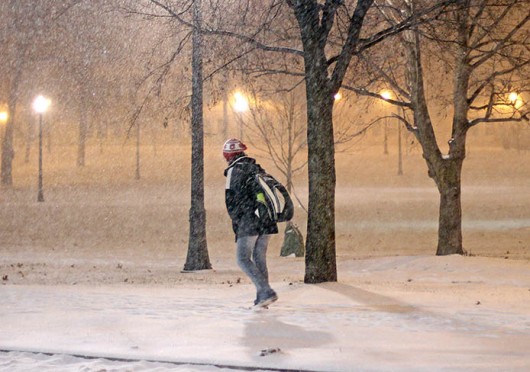Students feeling particularly bleak this winter might want to consider a trip to the doctor — it’s the time of year for seasonal affective disorder.
SAD is a type of depression that occurs at the same time each year, typically starting in the fall and running through the winter.
“Seasonal affective disorder is a biologically driven condition, and your daily body rhythms have gotten out of sync with the sun,” said Mary Fristad, professor of psychiatry, psychology and nutrition.
Denise Deschenes, senior staff psychiatrist at OSU Counseling and Consultation Services, said there are a number of signs someone could have SAD.
“Persons with SAD can experience significantly impaired daily functioning, hopelessness, helplessness and suicidal ideation. SAD is real depression that carries a risk of suicide as with other types of depression,” Deschenes said in an email. “In general, the incidence and severity of depression and anxiety are growing problems in the college population and have been for at least 20 years.”
She added that certain conditions can also put people at more risk.
“People in urban settings, working in windowless offices or who do not get outside as much can be more at risk,” Deschenes said. “People in the northern United States, Canada, Europe and Australia are most affected.”
Fristad said as such, Columbus residents are at risk.
“We know that in Columbus, Ohio, we’re in about the bottom 22nd percentile for days of sunshine in the U.S., so we’re prone to it here,” Fristad said.
She added that while roughly 35 million Americans are affected by SAD on some level, some people just have a mild case of winter blues.
“If you’re not studying for finals and you feel perfectly fine, you probably don’t have SAD,” Fristad said.
Randy Nelson, professor and the chair of the OSU Department of Neuroscience, said the condition affects people in different regions at different times.
“(It does) not merely reflect the holiday blues, because individuals suffering from SAD in the Southern Hemisphere display symptoms six months out of phase with Northern Hemisphere residents,” Nelson said in an email.
Deschenes said people who suspect they have SAD can seek help at Student Life’s OSU Counseling and Consultation Service.
“We see many students with SAD at Counseling and Consultation Service. They come in with new onset SAD, recurrent SAD, or with ongoing depression that became worse with the season,” she said.
Fristad said people who suspect they have SAD should keep record of what their mood is like each day and note what other stressors are affecting them. She added that before a diagnosis is reached, experts look for a pattern for about two years.
When such a diagnosis is made, treatment is readily available, Deschenes said.
“Mild to moderate symptoms respond well to just getting outdoors more often, even on cloudy days,” Deschenes said. “Exercise, especially outside, is very helpful. Regular sleeping and eating patterns, continuing to socialize and stress management are all proven interventions.”
Deschenes said getting more light can be helpful as well.
“If SAD happens every year, the person can look into getting a light box … which will mimic sunlight and reverse or improve the symptoms for many,” she said. “Thirty minutes exposure every morning will typically begin to show results in a few days.”
Some OSU students said they’ve experienced symptoms similar to those of SAD before.
Kathryn Ruddick, a third-year in psychology and criminology, said she moved to Ohio from Florida three years ago. For two winters, her family acted uncharacteristically rude toward one another, and she didn’t feel right, she said.
“I didn’t really want to get out of bed and I didn’t feel like doing anything, I had no motivation whatsoever,” Ruddick said.
A doctor recommended Ruddick’s family get checked for a seasonal disorder. The problem turned out to be a vitamin D deficiency, and Ruddick and her family have since cured the problem with vitamin D supplements, she said.
Nelson said SAD is set apart from non-seasonal depression in that people affected often have a desire to eat more often and feel sleepy during the day.
Fristad said if a student just doesn’t feel well on days they have a calculus exam, he or she likely does not have SAD.
Deschenes agreed.
“Students bounce back pretty quickly from situational stress,” Deschenes said. “Stress related to finals and other issues, like a breakup that happens in winter, will usually fade away once the stress is over. If self-help fails and the depression lingers for more than two weeks and causes significant impairment or suicidal thoughts, then seeking help is recommended.”



